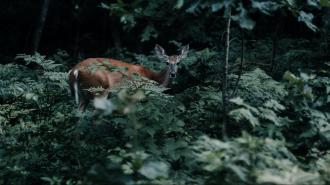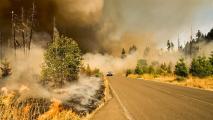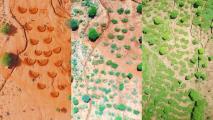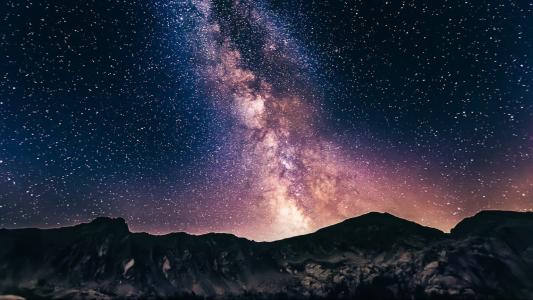Rewilding has gone global, and rewilding projects are growing in more than 70 countries across Asia, Africa, Europe, Australia, Latin America and North America.
The Global Rewilding Alliance, which was created in 2020, says rewilding the Earth will “stabilize the climate, halt mass extinction, and reduce the risks of new pandemics”.
So, what is rewilding and why are countries, governments and conservationists encouraging its use?
What is rewilding?
Rewilding is essentially about letting nature do its own thing.
Natural processes then shape the land and sea and repair parts that are damaged, explains Rewilding Europe, a Netherlands-based rewilding foundation.
Habitats are left to regenerate naturally and wildlife is free to flourish.
Rewilding examples can include reintroducing missing species and setting aside large areas for nature to grow on its own terms, explains conservation organization Rewilding Britain.
Reducing livestock grazing so trees and vegetation can grow and restoring marine ecosystems, like kelp forests and seagrass, are other rewilding examples.
Why is rewilding needed?
Habitat loss, human exploitation and climate change threaten one million animal and plant species with extinction over the coming decades, government scientists warn.
Biodiversity – the variety of species on Earth – provides the world with food, medicines, clean air and water but is already in crisis, says conservation organization the True Nature Foundation.
In Europe, for example, more than 80% of land is degraded and less than 30% of rivers are regarded as healthy.
Melting glaciers in the Arctic, the drying out of peatlands caused by hotter weather, damage caused by increasing floods, fires and droughts and “unsustainable agricultural systems” are among the threats damaging nature, True Nature says.
What are the benefits of rewilding?
Rewilding can help combat climate change and reverse species extinction, Rewilding Britain says.
Restored and biodiverse habitats naturally store more carbon, removing CO2 from the atmosphere, where it is warming the Earth and accelerating climate change. If woodlands, peat bogs, grasslands and other natural environments in the United Kingdom were restored, for example, they could lock away more than a tenth of the country’s greenhouse gas emissions a year.
Rewilding can return important species to environments where they play a vital role in species diversity and food chains, Rewilding Europe explains. Rural and urban communities can also earn a living from nature-based enterprises. Letting nature repair itself costs less than having humans actively managing the landscape. Being in nature is also good for our health and wellbeing, Rewilding Europe says.
Examples of rewilding projects
In Italy, a plan to rewild 100,000 hectares of landscape in the Central Apennines 1.5 hours from Rome includes protecting 50 to 60 Marsican brown bears, an endangered bear species.
Improved signage and measures to prevent traffic accidents are being introduced. A team of “bear ambassadors” has also been set up to communicate with local communities.
Other Rewilding Europe projects include reintroducing the Eurasian lynx to countries including Switzerland, Slovenia and Croatia, and growing Europe’s vulture populations.
In Ukraine, True Nature Foundation is helping to bring back lost species, including the Carpathian water buffalo. This will help to restore the wetland ecosystem around the Danube Delta, the second largest river delta in Europe.
In the western United States, ecologists have proposed rewilding 11 areas of government land to help the US fight climate change and protect more than 90 threatened species.
Restoring ecosystems around rivers and streams and boosting biodiversity would help to reduce the risk of wildfires and lower emissions by locking away more carbon in the landscape, the plan’s authors say.
Is rewilding always a good idea?
Rewilding is the source of much debate.
It is not about shutting local people and communities out of the landscape, BBC Science Focus magazine explains.
Rewilding can help people reconnect with nature, experts say, and rural communities should be involved in developing rewilding projects.
Not every location is suitable for rewilding and careful conservation management is needed to ensure unsuitable dominant species don’t take over, a commentary in The Spectator magazine explains.
There is also an argument that rewilding is a potential threat to food production, when the global population is rising and could reach 10 billion people by 2070.
A study on rewilding in the journal Land Use Policy led by Glasgow Caledonian University in Scotland suggests that biodiversity loss and food security are both challenges that need to be managed “within planetary boundaries”. Small farmers report that they are having to find trade-offs between producing food and coping with wildlife.
In a separate article in The Guardian newspaper, Rewilding Europe suggests there is no conflict between food production and rewilding. In the future, food will be produced more intensively in fewer areas, and less productive land will be used for rewilding, the organization says.
This article was reprinted with permission of the World Economic Forum, where it was originally published.






